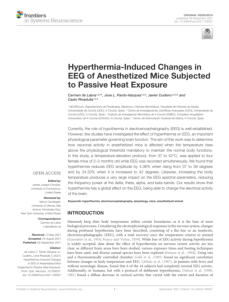Scientific papers 2021 - Part B









Authors:
Costantino Balestra, François Guerrero, Sigrid Theunissen,
Peter Germonpré, & Pierre Lafère
This study looked at technical divers during a wreck diving
expedition to gather data on decompression stress and
venous gas emboli (VGE) after deep dives. Ten divers
made three consecutive dives around 100 m, and VGE
counts were measured 30 and 60 minutes after surfacing
using echography and Doppler techniques. Body weight
and fluid shifts were also monitored.


Authors:
Robert P. Weenink, & Thijs T. Wingelaar.
Immersion in water increases hydrostatic pressure, which
counteracts gravity through buoyancy and reduces fluid
leakage from blood vessels. Cold water immersion causes
peripheral vasoconstriction, centralizing blood circulation.
A pressure difference between the lungs and body can
promote pulmonary edema. However, hydrostatic
pressure is evenly distributed in tissues and does not
compress them externally or resist blood flow vertically.
Cardiovascular collapse after rescue from water results
from gravity returning suddenly to a cold, vasoplegic
person, not from loss of hydrostatic pressure.


Authors:
Pierre Lafère, Kate Lambrechts, Peter Germonpré,
Ambre Balestra, Faye Lisa Germonpré, Danilo Cialoni,
Alessandro Marroni, Gerardo Bosco, & Costantino Balestra.
Heart rate variability (HRV) during underwater diving has
been infrequently investigated because of environmental
limitations and technical challenges. This study aims to
analyze HRV changes while diving at variable hyperoxia
when using an open circuit (OC) air diving apparatus or at
constant hyperoxia using a closed-circuit rebreather (CCR).
We used HRV analysis in the time and frequency domain
adding nonlinear analysis which is more adapted to short-
time analysis and less dependent on respiratory rate (Sinus
respiratory arrhythmia).


Authors:
Alexander Patrician, Frank Pernett, Angelica Lodin-
Sundström, Erika Schagatay.
Breath-hold diving (freediving) is an underwater sport that
is associated with elevated hydrostatic pressure, which has
a compressive effect on the lungs that can lead to the
development of pulmonary edema. Pulmonary edema
reduces oxygen uptake and
thereby the recovery from the hypoxia developed during
freediving, and increases the risk of hypoxic syncope. The
authors aimed to examine the blood oxygenation via
pulse-oximetry (SpO2), as a tool to detect pulmonary
edema by comparing it to lung ultrasonography
measurements after deep diving.


Authors:
Wilhelm W. Piispanen, Richard V. Lundell,
Laura J. Tuominen, Anne K. Räisänen-Sokolowski.
Cold water imposes many risks on the diver. These risks
include decompression illness, physical and cognitive
impairment, and hypothermia. Cognitive impairment can
be estimated using a critical flicker fusion frequency (CFFF)
test, but this method has only been used in a few studies
conducted in an open water environment.
The authors studied the effect of the cold and a helium-
containing mixed breathing gas on the cognition of
closed-circuit rebreather (CCR) divers.


Authors:
Roxane Monnoyer, Ingrid Eftedal, Astrid Hjelde,
Sanjoy Deb, Kjersti Haugum, & Jacky Lautridou.
The extreme environment in saturation diving affects all life
forms, including the bacteria that reside on human skin
and mucosa. The oral cavity alone is home to hundreds of
different bacteria. In this study, the authors examined the
metabolic activity of oral bacteria from healthy males
during commercial heliox saturation diving. They focused
on environmentally induced changes that might affect the
divers’ health and fitness.


Authors:
Kiyotaka Kohshi, Petar J. Denoble, Hideki Tamaki,
Yoshitaka Morimatsu, Tatsuya Ishitake, and
Frédéric Lemaître
Nitrogen accumulation in blood and tissues can happen
during breath-hold diving, leading to venous gas emboli
in commercial divers after repeated dives. This can cause
decompression illness (DCI). The syndrome "Taravana,"
seen in Polynesian pearl divers, is likely DCI and mostly
affects the brain. Neuroradiological studies on divers
showed various ischemic lesions linked to cerebral arterial
gas embolism.


Authors:
Xiao-Chen Bao, Quan Shen, Yi-Qun Fang, Jian-guo Wu
The objective of this study was to explore whether a single
deep helium-oxygen (heliox) dive affects physiological
function.
Forty male divers performed an open-water heliox dive to
80 m of seawater (msw). The total diving time was 280
min and the breathing helium-oxygen time was 20 min.
Before and after the dive, blood and saliva samples were
collected, and blood cell counts, cardiac damage,
oxidative stress, vascular endothelial activation, and
hormonal biomarkers were assayed.


Authors:
Peter Germonpré, Pierre Lafère, William Portier, Faye-Lisa
Germonpré, Alessandro Marroni, and Costantino Balestra.
Divers with a Patent Foramen Ovale (PFO) have an
increased risk for
decompression sickness (DCS) when diving with
compressed breathing gas. The relative risk increase,
however, is difficult to establish as the PFO status of divers
is usually only determined after a DCS occurrence.
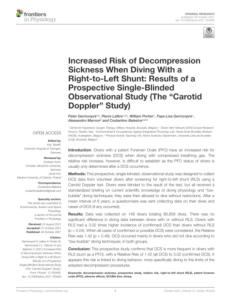

Authors:
Svein E. Gaustad, Timofei V. Kondratiev, Ingrid Eftedal,
Torkjel Tveita.
Diving in cold water is thought to increase the risk of
decompression sickness (DCS), especially if the diver is cold
during decompression.
In this study, the authors investigated hemodynamic
function and DCS risk in an animal model, where cold
decompression was followed by rewarming at the surface.
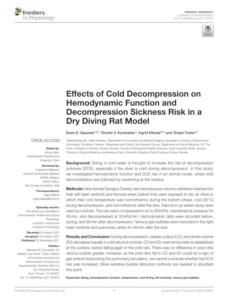

Authors:
Peter Kyriakoulis, Michael Kyrios, Antonio Egidio Nardi,
Rafael C. Freire, & Mark Schier.
Increased CO2 sensitivity is common in panic disorder (PD)
patients. Free-divers who are known for their exceptional
breathing control have lower CO2 sensitivity due to
training effects. This study aimed to investigate the
immediate effects of cold facial immersion (CFI), breath-
holding, and CO2 challenges on panic symptoms.


Authors:
Thomas Kjeld, Anders Brenøe Isbrand, Katrine Linnet, Bo
Zerahn, Jens Højberg, Egon Godthaab Hansen, Lars
Christian Gormsen, Jacob Bejder, Thomas Krag, John
Vissing, Hans Erik Bøtker, and Henrik Christian Arendrup.
The cardiac conduction system is sensitive to low blood
sugar and low oxygen, leading to slow heart rhythms.
Weddell seals and elite breath-hold divers experience
similar effects during dives. This study aims to define blood
glucose, oxygen saturation, heart rhythm, and blood
pressure in elite breath-hold divers during maximum
apneas.


Authors:
Kil-Hyung Han, Gwang-Suk Hyun, Yong-Seok Jee, & Jung-
Min Park
This study aimed to investigate the influence of pre-
hydration levels on circulating bubble formation for scuba
divers and evaluate the appropriate volume of water
intake before diving for reducing the risk of
decompression sickness. Circulating bubble measurements
using doppler were performed before and after a dive of
25 min and a depth of 30 m on twenty scuba divers who
were classified into four groups: no-water-intake, 30%-
water-intake, 50%-water intake, and 100%-water-intake.


Author: Ran Arieli
This study suggests nanobubbles, which appear at the
active hydrophobic spots at the luminal aspect of the blood
vessels, are the gas micronuclei from which the
decompression bubbles evolve, and endothelial injury
during the decompression is due to the tearing off of the
cell membranes with the detaching bubbles.
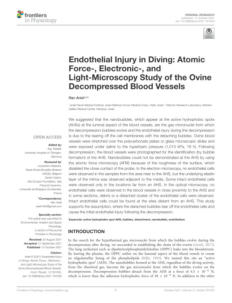

Authors: Robin Pla, Gauthier Poszalczyk, Cyrine Souaissia,
Fabrice Joulia, and Alexandre Guimard
This paper introduces an improving method that can
estimate the size of microbubbles in real time. Hence, the
measurement data of the liquid volume can be modified
according to this method. A microbubble detector based
on the pulsed-ultrasound method was studied, including
the device structure and the working principle.


Author: Yiqing Li, Junwu Wu, Leijie Fu, and Jinju Wang
Although the role of underwater phases is well-known, no
study has taken an interest in describing and quantifying
the distance and time spent in apnea as a condition for
optimal performance. This study aimed to investigate the
impact of time and distance spent underwater and surface
parameters on the swimming performance of elite
swimmers. The performances of 79 swimmers in 100-m
freestyle were analyzed (short-course).


Authors:
Christian Pristipino, Peter Germonpré, Danilo Toni, Horst
Sievert, Bernhard Meier, Fabrizio D’Ascenzo, Sergio Berti,
Eustaquio Maria Onorato, Francesco Bedogni, Jean-Louis
Mas, Paolo Scacciatella, David Hildick-Smith, Fiorenzo
Gaita, Paul A. Kyrle, John Thomson, Genevieve
Derumeaux, Dirk Sibbing, Massimo Chessa, Marius
Hornung, Jose Zamorano, Dariusz Dudek
This interdisciplinary paper, prepared with the involvement
of eight European scientific societies, reviews the available
evidence and proposes a rationale for decision making for
other Patent Foramen Ovale related clinical conditions.
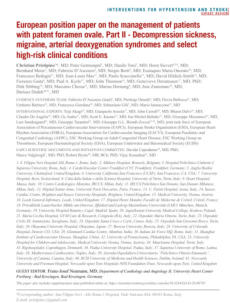

Authors:
Danilo Cialoni, Andrea Brizzolari, Michele Samaja, Gerardo
Bosco, Matteo Paganini, Nicola Sponsiello, Valentina
Lancellotti, and Alessandro Marron.
Nitric oxide (NO) is an essential signaling molecule
modulating the endothelial adaptation during breath-hold
diving (BH-diving). This study aimed to investigate
changes in NO derivatives (NOx) and total antioxidant
capacity (TAC), searching for correlations with different
environmental and hyperbaric exposure.


Authors:
Shumaila Mumtaz, Shaukat Ali, Hafiz Muhammad Tahir,
Syed Akif Raza Kazmi, Hafiz Abdullah Shakir,
Tafail Akbar Mughal, Samaira Mumtaz,
Muhammad Summer, Muhammad Adeel Farooq
This purely medical document has been selected because
it discusses using vitamin C as an antioxidant to combat
oxidative stress triggered by reactive oxygen species. As
explained in our handbooks, reactive oxygen species are
necessary for life. However, they can be involved in cell
destruction when produced in excess, which happens
when the body is confronted with abnormal situations,
such as breathing oxygen at elevated Partial pressure.
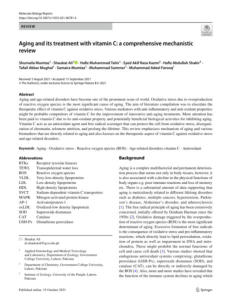

Authors:
Edward P. Manning, Abhay B. Ramachandra, Jonas C.
Schupp, Cristina Cavinato, Micha Sam Brickman Raredon,
Thomas Bärnthaler , Carlos Cosme Jr., Inderjit Singh,
George Tellides, Naftali Kaminski, and Jay D. Humphrey
Hypoxia adversely affects the pulmonary circulation of
mammals, including vasoconstriction leading to elevated
pulmonary arterial pressures.
The authors established a multi-disciplinary workflow to
understand better transcriptional, microstructural, and
functional changes of the pulmonary artery in response to
sustained hypoxia and how these changes inter-relate.


Author: Rutger C Lalieu, Ida Akkerman, Peter-Jan AM van
Ooij, Annieke A Boersma-Voogd, Rob A van Huls
Due to the global rise of obesity, the role of nutrition has
gathered more attention. Paradoxically, even overweight
persons may be malnourished. This may delay wound
healing or recovery of late radiation tissue injury (LRTI).
Hyperbaric oxygen treatment (HBOT) is used to improve
wound healing or LRTI complaints. The aim of this study
was to assess the dietary intake levels of nutrients
important for recovery in patients referred for HBOT.


Author:
Yan Tian, Yafang Zhang, Yu Wang, Yunxi Chen, Weiping
Fan, Jianjun Zhou, Jing Qiao, and Youzhen Wei
Molecular hydrogen (H2) is a colorless and odorless gas.
Studies have shown that H2 inhalation has therapeutic
effects in many animal studies and clinical trials. Its
application has recently been recommended in China's
novel coronavirus pneumonia treatment guidelines.
H2 is primarily administered via inhalation, drinking H2-rich
water, or injection of H2 saline. It may participate in the
anti-inflammatory and antioxidant activity and immune
system regulation by annihilating excess reactive oxygen
species production and modulating nuclear transcription
factors.


Authors: Karin Biering, Anette Kærgaard, Ole Carstensen,
Kent Jacob Nielsen.
This study aimed to monitor exposure to electrical shocks
weekly over six months and to determine whether these
shocks have short-term, health-related consequences. Its
results should be considered for the safety of surface
technicians involved in the maintenance of Diving and
ROV systems.
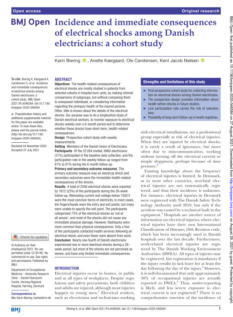

Authors: Tobias Cibis & Carolyn McGregor
This book overviews the technical and clinical challenges
of living and working in extreme environments. It blends
the story of physiological and psychological adaptation to
harsh environments on Earth and the two final frontiers of
space and the undersea world. It also discusses new
technologies and the role of artificial intelligence in
helping monitor and detect physiologic decompensation,
illness, or injury.


Authors: Oskari H Lindfors, Anne K Räisänen-Sokolowski,
Jari Suvilehto, Saku T Sinkkonen
Sinus barotrauma while diving is considered to be the
consequence of insufficient paranasal sinus ventilation
during ambient pressure changes, when either ascending
or descending on a dive, or when diving in a multilevel
environment. The sinuses most often affected are
considered to be the frontal and maxillary sinuses, while
involvement of the sphenoid and ethmoid sinuses is
thought to be less common.
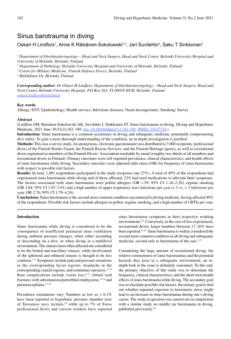

Authors:
Barbara Nieradko-Iwanicka, Daria Przybylska, Piotr
Siermontowski, Cezary J. Kowalski, Marta Wójciak-Czuła,
Andrzej Borzecki
Hyperbaric oxygen therapy is a method supporting the
treatment of many diseases. Oxygen therapy treatments
are conducted in hyperbaric chambers, in which patients
breathe pure, 100% oxygen with higher than atmospheric
pressure. This allows to increase the amount of oxygen
supplied to all cells of the body many times over. The
treatment with hyperbaric oxygen therapy enables the
patient to recover faster and be fully active, and also
reduces the costs of standard treatment.
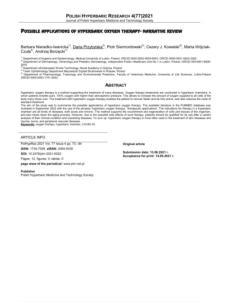

Authors:
Alessandro Belletti, Giovanni Landoni, Alberto Zangrillo
In their multicenter study, the Authors present incidence,
clinical characteristics and outcome of pneumothorax in
critically ill patients with coronavirus disease 2019
(COVID-19). They found that pneumothorax rate among
invasively ventilated COVID-19 patients is 80/594
(13 %), and mortality rate for patients who developed
pneumothorax is 50/80 (62 %). On the contrary, among
160 randomly selected invasively ventilated COVID-19
patients without pneumothorax, mortality was 78/160
(49 %).


Authors: Wen-Jie Wang, Jia-Sheng Ding, Qing Sun, Xiang
Xu, Gang Chend
Gliomas are common brain masses with a high mortality
rate. Patients with gliomas have a severely poor outcome,
with an average survival
duration of less than 15 months due to high recurrence
rates and resistance to radiotherapy and chemistry drugs
therapy. Hyperbaric oxygen is extensively used as an
adjuvant treatment for various disease conditions. The
authors found that, in general, hyperbaric oxygen shows
an obvious positive effect on the treatment of gliomas,
and it can also relieve the complications caused by
postoperative radiotherapy and chemotherapy of gliomas.
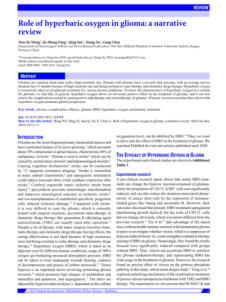

Authors: Selahattin Çakiroglu, Ertugrul Kerimoglu,
Bengüsu Mirasoglu
Dysbaric osteonecrosis (DON) is a type of avascular bone
necrosis observed in divers and pressure environmental
employees. Early diagnosis is particularly crucial in DON.
The lesions can be detected through bone scintigraphy,
magnetic resonance imaging (MRI), or direct radiography.
Hyperbaric oxygen therapy has been successfully used to
treat avascular necrosis in the early stages of avascular
necrosis. Early results of hyperbaric oxygen therapy
(HBOT) showed positive outcomes in the treatment of
DON.
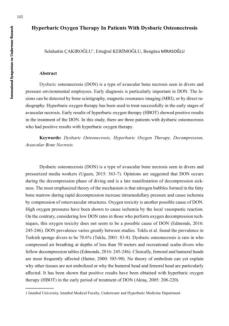

Authors: Micaela Tobler, Christos T. Nakas, Matthias P. Hilty,
Andreas Huber, Tobias M. Merz, and Jacqueline
Pichler Hefti
Changes in blood coagulation during exposure to high
altitude is not fully understood. Also, studies on the
activation and consumption of specific coagulation factors
in hypoxic humans have yielded conflicting results. The
authors used thromboelastometry (TEM), which allows for
a global evaluation of clot formation and lysis processes, to
study blood coagulation profiles in volunteers exposed to
prolonged hypobaric hypoxia at extreme altitudes..


Author: Hussam Haider Salman, Adnan khudhier yaqoop,
Rafid Y. Jabbar Almaidi
Tympanometry is an objective test that measures the
mobility (compliance) of the tympanic membrane as a
function of applied air pressure in the external canal. It is
particularly useful in assessing the secretory otitis media
during childhood. This is a prospective study performed at
the ENT department of the Basrah Teaching Hospital for
the period from November / 2013 to February / 2014.
The study aims to assess the advantages of tympanometry
as a diagnostic tool and to audit the use of tympanometry
in ear diseases in the ENT department of the Basrah
Teaching Hospital.
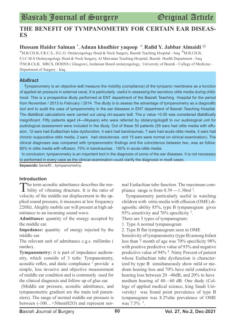

Authors: Andreas Fichtner, Benedikt P. Brunner, Thomas
Pohl, Thomas Grab, Tobias Fieback, Thea Koch
The authors taught audio Doppler self-assessment of
subclavian and precordial probe positions to 41 divers in a
45-minute standardized, didactically optimized training
session. In conclusion, the authors suggest that although
accurate bubble grading is not possible under dive site
conditions, non-professionals can detect relevant high
bubble grades. This qualitative information may be
important for self-assessment of decompression stress and
for evaluating measures to increase diving safety.
Authors:
Pierre Lafère, Kate Lambrechts, Peter Germonpré,
Ambre Balestra, Faye Lisa Germonpré, Danilo Cialoni,
Alessandro Marroni, Gerardo Bosco, & Costantino Balestra.
Heart rate variability (HRV) during underwater diving has
been infrequently investigated because of environmental
limitations and technical challenges. This study aims to
analyze HRV changes while diving at variable hyperoxia
when using an open circuit (OC) air diving apparatus or at
constant hyperoxia using a closed-circuit rebreather (CCR).
We used HRV analysis in the time and frequency domain
adding nonlinear analysis which is more adapted to short-
time analysis and less dependent on respiratory rate (Sinus
respiratory arrhythmia).


Authors: Rickard Ånell, Mikael Grönkvist, Mikael Gennser,
Ola Eiken
This study investigated whether an early excursion from
high to moderate altitude can reduce high-altitude
decompression strain. The conclusion is that an early,
single excursion from high to moderate cabin altitude
holds promise as an in-flight means of reducing the risk of
altitude decompression sickness during long-duration
high-altitude flying in aircraft with limited cabin
pressurization.
This document should be considered for travel by non-
pressurized aircraft after diving.
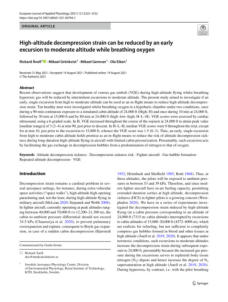

Authors: Chao Tan, Yuichi Murai, Weiling Liu, Yuji Tasaka,
Feng Dong , Yasushi Takeda
Ultrasound Doppler measures multiphase flow velocities
non-intrusively, aiding in fluid dynamics analysis, industrial
safety, and process optimization. This review discusses its
principles, developments, and the measurement of various
flow types, highlighting the technique's benefits,
limitations, and future directions.


Author: Roxane Monnoyer, Jacky Lautridou, Sanjoy Deb,
Astrid Hjelde, and Ingrid Eftedal
The authors investigated whether measuring salivary
biomarkers in samples collected by the divers themselves
would be a feasible approach for assessing environmental
stress. Nine saturation divers were trained in saliva
collection methods and collected samples before, during,
and after an offshore commercial saturation diving
campaign.
During the dive, some salivary biomarkers were found to
increase significantly, while others remained unchanged.
This suggests that this method is suitable for assessing
stress levels during saturation diving.
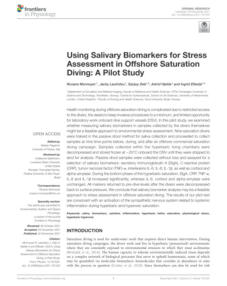


Click on the octopus
to return to the top
of the page


Authors: Kay Tetzlaff, Frederic , Christof Burgstahler, Julian
A. Luetkens, & Lars Eichhorn
This study explains the environmental stressors, such as
water immersion, hydrostatic pressure, and asphyxia, that
affect the respiratory system during such dives. It discusses
the physiological adaptations and techniques used by elite
breath-hold divers to achieve extreme depths, as well as
the potential medical risks, including nitrogen narcosis and
decompression stress, associated with deep breath-hold
diving. Also, it highlights that the ultimate goal is to
enhance understanding of pulmonary physiology at
depth and to assess the medical risks involved.


Authors: Miguel A. Ortega, Oscar Fraile-Martinez, Cielo
García-Montero, Enrique Callejón-Peláez, Miguel
A. Sáez, Miguel A. Álvarez-Mon, Natalio García-
Honduvilla, Jorge Monserrat, Melchor Álvarez-
Mon, Julia Bujan, and María Luisa Canals
This paper is a comprehensive review of Hyperbaric
Oxygen Therapy (HBOT) that discusses its physiological
relevance and therapeutic basis, including its current
indications, underlying mechanisms, and potential areas
for future research. It also intends to examine the adverse
effects and contraindications associated with HBOT and
encourage further research to expand its clinical
applications.
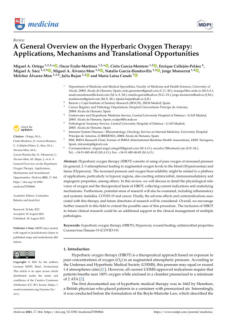

Authors: Fichtner A, Chekhanova A, Wuensche A, Starkloff
HJ, Fieback T, Koch T.
This study investigates the relationship between dive
profiles, individual parameters, and fluid loss in SCUBA
divers. It develops an estimation of the necessary amount
of fluid restoration between dives to reduce the risk of
decompression sickness, in addition to outlining the
methods used, the results obtained, and the discussion of
the findings, emphasizing the importance of sufficient
hydration for divers and the challenges in quantifying fluid
loss mechanisms.
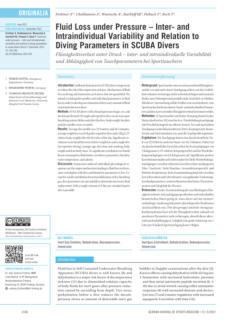

Author: Omar M. Abdelfattah, Ahmed Sayed, Islam Y.
Elgendy, Malak Munir, , Yehia Saleh, Samir R.
Kapadia, George S. Abela, Hani Jneid
This study evaluates the benefits and risks of patent
foramen ovale (PFO) closure in preventing decompression
sickness among divers. It determines whether PFO closure
reduces the incidence of decompression sickness and
assesses the associated adverse events. The authors
provide a detailed methodology, results, and conclusion
based on the analysis of observational studies.
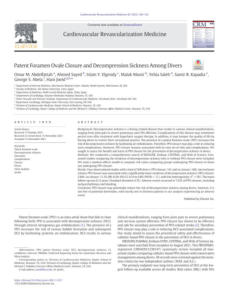

Authors:
Janne Bouten, Sander De Bock, Gil Bourgois, Sarah de
Jager, Asmien Dumortier, Jan Boone, and Jan G. Bourgois
This study investigates the cardiovascular and metabolic
responses to dynamic dry apnea (DRA) and face
immersed apnea (FIA) in young female volunteers to
compare the effects of these two conditions on heart rate,
muscle tissue oxygenation, and lactate levels during
breath-holds while cycling. It provides detailed methods,
results, and conclusions, highlighting the physiological
responses observed, such as bradycardia and changes in
muscle oxygenation, and discusses the implications of
these findings.
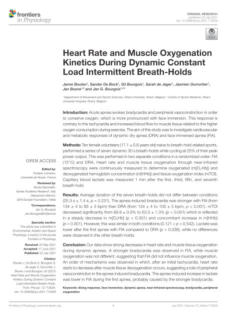

Authors: V P Polivtsev, V V Polivtsev, K N Osipov
This study explores the development and testing of liquid
respiration technology designed for safely diving and
surfacing biological objects, specifically in the Black Sea. It
involves using an autonomous capsule system and
includes medical research to monitor the health and safety
of a dog during the process. The text outlines the
methodology, technology, and findings related to safe
diving practices and the physiological effects on the
biological object.
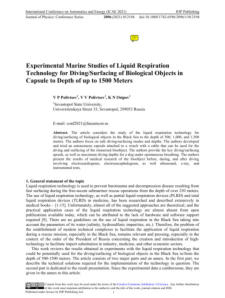

Author: Marguerite St Leger Dowse, Sophie Howell, Gary
R Smerdon
This study examined the adherence of divers to the
recommended pre-flight surface interval (PFSI) of 24 hours
or more after diving vacations and assessed any perceived
signs and symptoms of decompression sickness (DCS)
during or after flights. The study aims to evaluate the
safety and outcomes associated with following or not
following these guidelines.
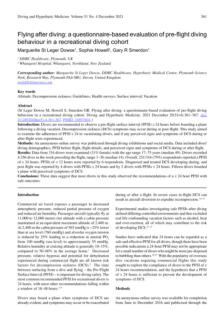



03 - Effect of Water Amount Intake before Scuba Diving on the Risk
of Decompression Sickness
- Published by International Journal of environmental Research and Public Health - MDPI
Authors: Kil-Hyung Han, Gwang-Suk Hyun, Yong-Seok
Jee, and Jung-Min Park
This study examined how pre-hydration levels affect
bubble formation in scuba divers and determine the right
water intake to lower decompression sickness (DCS) risk.
Twenty divers were split into four groups based on their
water intake. Results showed the 30%-water-intake group
had the lowest bubble formation after diving. Therefore,
pre-hydration with 30% of daily water intake is suggested
to reduce bubble formation and DCS risk.
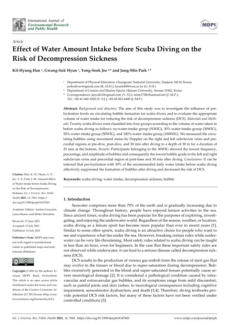



11 - Heart Rate and Muscle Oxygenation Kinetics During Dynamic
Constant Load Intermittent Breath-Holds
- Published by Frontiers
Authors: Janne Bouten, Sander De Bock, Gil Bourgois,
Sarah de Jager, Jasmien Dumortier, Jan Boone,
and Jan G. Bourgois
This study examined cardiovascular and metabolic
responses of dynamic dry apnea (DRA) and face
immersed apnea (FIA) in ten young female volunteers.
They performed seven 30-second breath-holds while
cycling, measuring heart rate and muscle oxygenation.
Results showed stronger bradycardia in FIA and a notable
drop in muscle oxygenation. Lactate levels were lower
after the first FIA breath-hold. Ultimately, FIA did not affect
muscle oxygenation despite stronger bradycardia.




47 - Swim performance with and without snorkel and the
underlying energetic differences
- Published by the Undersea & Hyperbaric Medical Society (Author-released)
Author: Nico A.M. Schellart
Decompression illness (DCI) is recognized in compressed-
air diving and also reported in breath-hold divers like the
Japanese Ama. It often shows neurological symptoms,
particularly stroke-like events. Treatment with oxygen is
recommended, and prevention strategies include
reducing extreme diving.
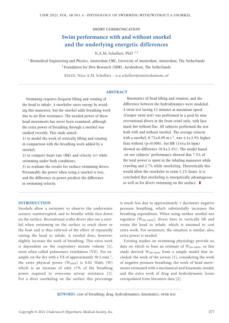



48 - Effect of types of resin cements on the bond strength of fiber
post under simulated dives
- Published by the Undersea & Hyperbaric Medical Society (Author-released)

Authors: Ting Khee Ho, Mohd Najib Md Razi, Natasya
Ahmad Tarib
Changes in barometric pressure during flying and diving
under hyperbaric conditions affect dental restorations.
This study evaluated the bond strength of glass fiber posts
using two different cements under normal and hyperbaric
pressure. Results showed that RelyX Ultimate had higher
bond strength at normal pressure, but both cements
performed similarly under hyperbaric conditions.
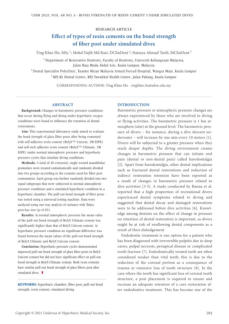



49 - Inner ear decompression sickness in Finland: a retrospective 20-
year multicenter study
- Published by the Undersea & Hyperbaric Medical Society (Author-released)
Author: Oskari H. Lindfors, Richard V. Lundell, Olli J.
Arola, Timo P. Hirvonen, Saku T. Sinkkonen,
Anne K. Räisänen-Sokolowski.
Inner ear decompression sickness (IEDCS) affects many
patients, often leaving them with lingering symptoms. It
can occur in both technical and recreational dives. This
study reviewed IEDCS patients from 1999 to 2018,
focusing on symptoms and recovery rates. Most patients
had severe vestibular symptoms, and recovery rates varied
between divers. The incidence of IEDCS in Finland is
rising, suggesting a need for thorough examinations after
incidents.
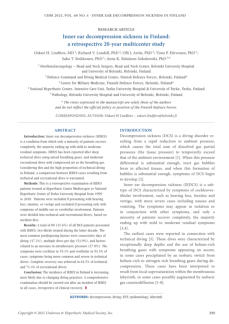



50 - Performance of the Uni-Vent Eagle Model 754 ventilator under
hyperbaric conditions.
- Published by the Undersea & Hyperbaric Medical Society (Author-released)
Author: Daniel Popa, Lynn Waterhouse, Jay Duchnick,
Tom Neuman, Peter Witucki
Critically ill patients needing mechanical ventilation may
require hyperbaric oxygen therapy. This study examines
the Uni-Vent Eagle™ model 754's performance under
hyperbaric conditions and addresses potential oxygen
leaks in the ventilator housing. The ventilator delivered less
volume at higher pressures, but oxygen levels remained
stable within the housing. The model performed safely at
depth but requires spirometry for proper settings.




51 - Varied effects exerted on sudden sensorineural hearing loss
through HBO2 therapeutic pressure
- Published by the Undersea & Hyperbaric Medical Society (Author-released).

Authors: Chen Chen, Heng Hu, Rui-yong Chen
This study compared the effectiveness of two pressures, 2.
0 ATA and 2. 2 ATA, in hyperbaric oxygen therapy for
sudden sensorineural hearing loss. Records of 160
patients were reviewed. Higher pressure showed better
hearing improvement, especially in certain frequency
ranges, suggesting pressure affects treatment success.
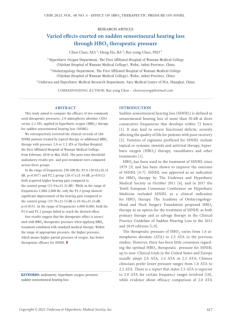



52 - Treatment outcomes on neovascularization after CRAO treated
with hyperbaric oxygen.
- Published by the Undersea & Hyperbaric Medical Society (Author-released).
Author: Nicole Lifson,George Salloum, Philip Kurochkin,
Michael Bivona, Han Y. Yin, Samuel Alpert
Central retinal artery occlusion (CRAO) causes sudden
vision loss from retinal artery blockage, often linked to risk
factors like heart disease and diabetes. CRAO can worsen
vision through neovascularization, which can be painful.
Hyperbaric oxygen (HBO2) therapy is evaluated for
treating CRAO. This study shows 20% of patients treated
with HBO2 developed neovascularization, compared to
29. 8% without it, indicating HBO2 may help protect
vision and improve long-term outcomes.
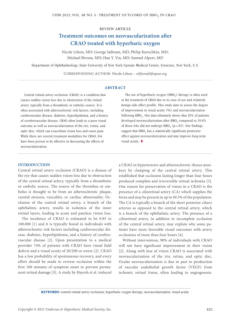



53 - Repetitive hyperbaric oxygen therapy for paroxysmal
sympathetic hyperactivity a er acute carbon monoxide
poisoning.
- Published by the Undersea & Hyperbaric Medical Society (Author-released).
Authors: Sangchun Choi, Hyuk-Hoon Kim, Seong Beom
Oh, Yoon Seok Jung
Delayed neuropsychological sequelae (DNS) often arise
after carbon monoxide (CO) poisoning and can include
memory loss, confusion, and motor disturbances.
Paroxysmal sympathetic hyperactivity (PSH) can occur
after brain injuries, causing serious complications. This
report describes three cases where patients improved
from PSH as DNS following hyperbaric oxygen therapy.
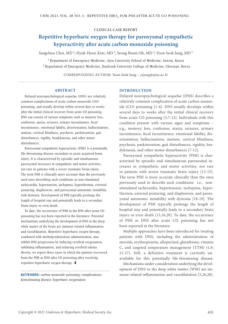



54 - Inner ear decompression sickness in a hyperbaric chamber
inside tender: a case report.
- Published by the Undersea & Hyperbaric Medical Society (Author-released).
Author: Dominique Gelmann, Gregory Jasani, Siamak
Moayedi, Douglas Sward
Inner ear decompression sickness (IEDCS) is a rare diving
issue with vestibular and cochlear problems. A 55-year-old
man developed IEDCS after working in a hyperbaric
chamber and was treated successfully with hyperbaric
oxygen therapy.
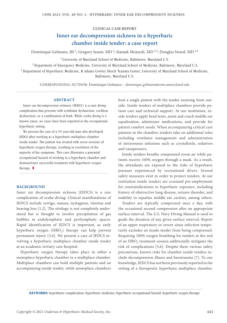



55 - Hyperbaric oxygen for thermal burns
- Published by the Undersea & Hyperbaric Medical Society (Author-released).

Author: Paul Cianci, Ronald M. Sato, Julia Faulkner
Research shows that hyperbaric oxygen therapy can help
prevent skin damage, reduce swelling, and promote
healing from thermal injuries. It also reduces deaths,
hospital stays, surgeries, and costs. Proper training and
patient selection are essential.




56 - Variability in venous gas emboli following the same dive at
3,658 meters
- Published by the Undersea & Hyperbaric Medical Society (Author-released).
Author: Hayden W. Hess, Courtney E. Wheelock, Erika St
. James, Jocelyn L. Stooks, Brian M. Clemency,
David Hostler
Exposure to low pressure, like high-altitude climbing or
diving, leads to gas bubbles in blood (venous gas emboli,
VGE). These bubbles help measure decompression stress
and risk of decompression sickness (DCS), typically
managed by decompression schedules. A study
examined VGE after simulated altitude dives at 12,000
feet, with ten divers diving twice. No symptoms of DCS
were observed, and most dives showed low VGE levels,
indicating minimal decompression stress.
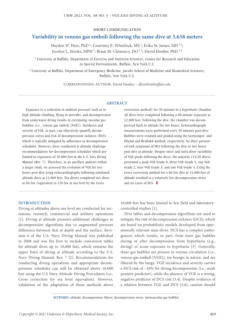



57 - Effects of Cold Decompression on Hemodynamic Function and
Decompression Sickness Risk in a Dry Diving Rat Model
- Published by Frontiers
Author: Svein E. Gaustad, Timofei V. Kondratiev,
Ingrid Eftedal, and Torkjel Tveita
Diving in cold water may raise the risk of decompression
sickness (DCS), especially during decompression. This
study examined hemodynamic function and DCS risk
using nine female Sprague Dawley rats. They were
exposed to various temperatures during a controlled dive
and decompression. Results showed similar cardiac
output and stroke volume changes in both cold and
normal temperature rats, but further research is needed
for clearer results on DCS risk.
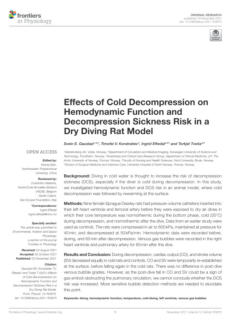




Authors: C.J. Edge, and P.T. Wilmshurst
This article discusses the physiological effects of breathing
gases at altered partial pressures and common diving-
related diseases. It also highlights medical conditions that
affect diving safety, such as pulmonary barotrauma, toxic
gases, decompression sickness, and immersion pulmonary
oedema. Understanding the behavior of gases under
pressure is crucial for safe diving.




09 - Bioelectric impedance analysis for body composition
measurement and other potential clinical applications in critical
illness
- Published by Current Opinion in Critical Care.
Authors: Hanneke Pierre Franciscus Xaverius Moonen,
and Arthur Raymond Hubert Van Zanten
Bioelectric impedance analysis (BIA) is a valuable tool for
understanding body composition, but its interpretation in
critically ill patients remains challenging. Recent findings
show a correlation between raw impedance parameters,
fluid ratios, overhydration, and adverse outcomes. BIA-
derived muscle mass is a promising biomarker for
sarcopenia, while body cell mass and fat-free mass can
estimate metabolic rate, protein requirements, and
pharmacokinetics. Further research is needed to validate
bioimpedance interpretation in critical care.




10 - Intercostal Muscles Oxygenation and Breathing Pattern during
Exercise in Competitive Marathon Runners
- Published by the International Journal of environmental Research & Public Health - MDPI
Authors: Janne Boute
This study examined the relationship between changes
in ventilatory variables and deoxygenation of
m.intescostales during maximal incremental exercise in
19 male high-level competitive marathon runners.
Results showed that ΔSmO2-m.intercostales correlated
with VO2-peak and increased lung ventilation and
respiratory rate, but not tidal volume. The deoxygenation
of m.intercostales was directly associated with aerobic
capacity and increased lung ventilation and respiratory
rate, but not tidal volume.




25 - Effect of Cold Stress on Neurobehavioral and Physiological
Parameters in Rats
- Published by Frontiers
Authors: Hajar El Marzouki, Youssef Aboussaleh,
Mohamed Najimi, Fatiha Chigr, and Ahmed
Ahami
This study found that exposure to cold for 2 hours
increased the relative weight of adrenal glands in male
rats, while female rats showed decreased food intake
and no change in body weight. Both sexes performed Y
maze and object recognition tasks, indicating intact
spatial working memory performance and object
recognition abilities. However, stress caused an increase
in anxiety in male rats, indicating that gender is an
important consideration in experimental design.
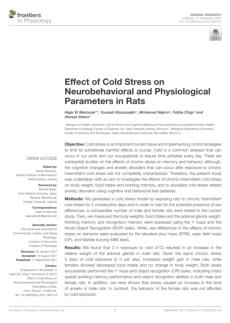




Authors: Esen Yonca Bassoy, Michael Walch, and Denis
Martinvalet
The immune system protects the host from various
microorganisms and toxins through two lines of defense:
the innate immune system, which uses anatomical
barriers, physiological factors, and leukocytes, and the
adaptive immune system, which relies on T and B
lymphocytes for elimination and immune memory
formation. Reactive oxygen species (ROS) play a crucial
role in these immune responses, contributing to T-cell
biology and potentially extrapolating to B cells.
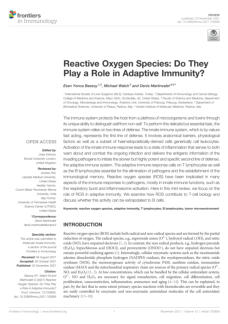

Authors: Carmen de Labra, Jose L. Pardo-Vazquez, Javier
Cudeiro, and Casto Rivadulla
This article investigates the impact of hyperthermia on
electroencephalography (EEG) in anesthetized mice,
focusing on how elevated temperatures above
physiological norms affect neuronal activity. By applying a
temperature-elevation protocol from 37 to 42 degrees
Celsius, the study reveals that hyperthermia significantly
reduces EEG amplitude and alters spectral parameters
across various frequency bands, indicating a global effect
on brain electrical activity.
